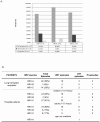Rhinovirus genome variation during chronic upper and lower respiratory tract infections
- PMID: 21713005
- PMCID: PMC3119694
- DOI: 10.1371/journal.pone.0021163
Rhinovirus genome variation during chronic upper and lower respiratory tract infections
Abstract
Routine screening of lung transplant recipients and hospital patients for respiratory virus infections allowed to identify human rhinovirus (HRV) in the upper and lower respiratory tracts, including immunocompromised hosts chronically infected with the same strain over weeks or months. Phylogenetic analysis of 144 HRV-positive samples showed no apparent correlation between a given viral genotype or species and their ability to invade the lower respiratory tract or lead to protracted infection. By contrast, protracted infections were found almost exclusively in immunocompromised patients, thus suggesting that host factors rather than the virus genotype modulate disease outcome, in particular the immune response. Complete genome sequencing of five chronic cases to study rhinovirus genome adaptation showed that the calculated mutation frequency was in the range observed during acute human infections. Analysis of mutation hot spot regions between specimens collected at different times or in different body sites revealed that non-synonymous changes were mostly concentrated in the viral capsid genes VP1, VP2 and VP3, independent of the HRV type. In an immunosuppressed lung transplant recipient infected with the same HRV strain for more than two years, both classical and ultra-deep sequencing of samples collected at different time points in the upper and lower respiratory tracts showed that these virus populations were phylogenetically indistinguishable over the course of infection, except for the last month. Specific signatures were found in the last two lower respiratory tract populations, including changes in the 5'UTR polypyrimidine tract and the VP2 immunogenic site 2. These results highlight for the first time the ability of a given rhinovirus to evolve in the course of a natural infection in immunocompromised patients and complement data obtained from previous experimental inoculation studies in immunocompetent volunteers.
Conflict of interest statement
Figures



References
-
- Johnston SL, Pattemore PK, Sanderson G, Smith S, Campbell MJ, et al. The relationship between upper respiratory infections and hospital admissions for asthma: a time-trend analysis. Am J Respir Crit Care Med. 1996;154:654–660. - PubMed
Publication types
MeSH terms
LinkOut - more resources
Full Text Sources

